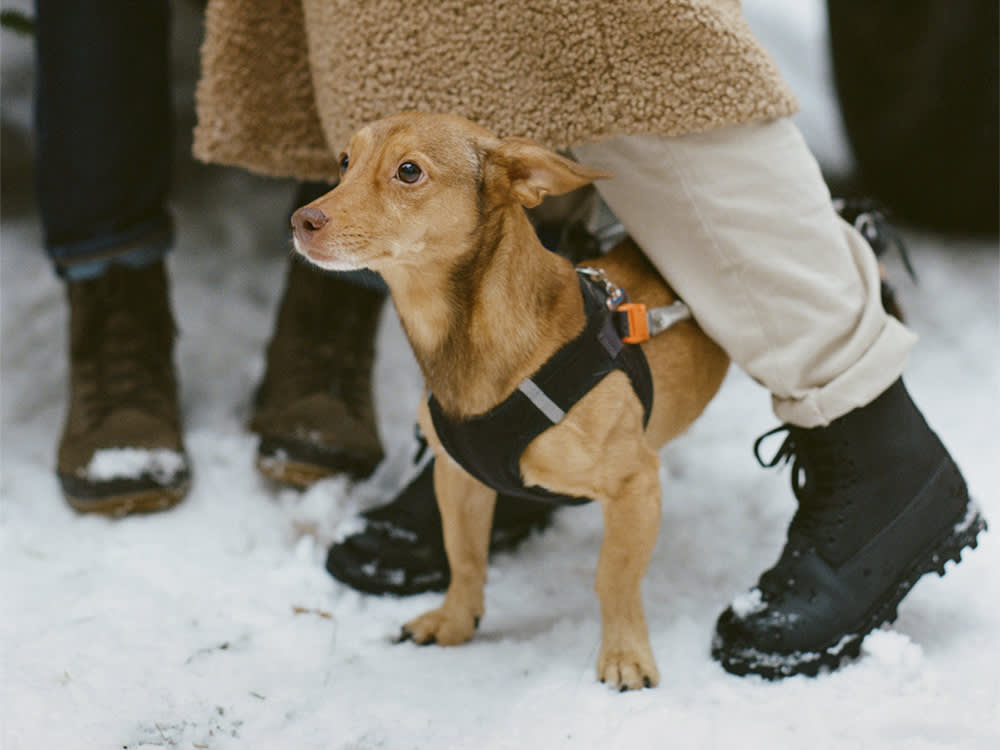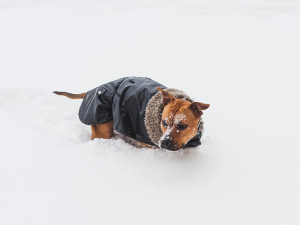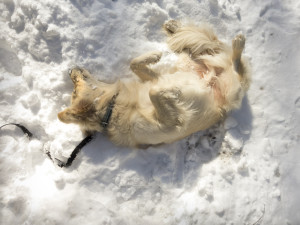The Chilling Truth About Dog Frostbite
Yep, all those warnings your mum gave you as a kid apply to your dog, too. Learn how to keep your pup safe in the cold

Share Article
In this article:
Signs of frostbite How fast can dogs get frostbite? Common locations for frostbite in dogs How frostbite is treated Prognosis of frostbite in dogs Tips to avoid frostbite in dogs
This winter, you and your pup are all set to beat the seasonal depression together by going on a lot of adventures. First of all, they look adorable as they bunny-hop through the snow (if we get any). And you both can benefit from some fresh air. But before you set off on your magical winter walk, remember: dogs can get frostbite. Common areas include their ears, paws and the tip of their tail. Symptoms include swelling, pain and pale or greyish skin that is cold to the touch. If you suspect your dog has frostbite, it’s crucial to seek veterinary attention
Most of us have been warned throughout our lives not to stay out in the cold too long, lest the vampiric-sounding ‘frostbite’ set in. According to Dr Tammy Hunter and Dr Ernest Ward, frostbite occurs when the temperature drops below freezing and blood vessels close to our skin start to constrict to preserve our core body temperature. In extreme cold or when we’re outside for long periods, this can reduce blood flow in some areas of the body, allowing them to freeze and causing severe tissue energy. And it’s not unique to humans – our pups are at risk, too.
Clinical signs of frostbite
Per Dr Ward, the signs associated with frostbite include:
Discolouration of the affected area of skin – often pale, grey or blue
Coldness and/or brittleness of the area when touched
Pain when you touch the affected area
Swelling of the affected area
Blisters or skin ulcers
Areas of blackened or dead skin
As frostbitten tissues thaw, they may become red and very painful due to inflammation. The clinical signs of frostbite may take several days to appear, especially if the affected area is small, such as the tip of the tail or ears. Severely frostbitten areas will develop necrosis (die off). As the tissue starts to die, it changes to dark blue to black; then, over a period of several days to weeks, it falls off. Dogs with heart disease, diabetes mellitus, or other conditions that cause reduced blood flow to the extremities are at greater risk for frostbite.
How fast can dogs get frostbite?
Frostbite can develop in as little as 15 to 30 minutes or over several hours. Changes in circulation that start the process can start within five minutes of continuous cold exposure. The speed that dogs can get frostbite varies and depends on factors like ambient temperature, moisture, wind and level of exposure. While frostbite can start to develop quickly, its full effect on the skin and tissues beneath may not be seen for days.
What are the most common locations for frostbite?
Dogs are most likely to develop frostbite on areas of the body where the skin and blood vessels are not well-protected by fur: the nose, ears, paws, tail and genitals.
Frostbite on the nose: as dogs explore the world with their sniffers, their noses can make contact with cold surfaces. Being hairless and often wet makes dog noses vulnerable to cold.
Frostbite on the ears: dog ears are vascular and thin-haired, leaving the blood vessels with little protection, especially in windy conditions.
Frostbite on paws: dog paws are in direct contact with cold, snowy, and icy surfaces, which puts them at increased risk for developing frostbite.
How frostbite is treated
Per D. Hunter, if you suspect your dog has frostbite, you should seek medical attention immediately.
In the meantime, you can do the following:
Move your dog to a warm, dry area as quickly and as safely as possible.
If your dog is suffering from hypothermia or low core body temperature, treat the hypothermia first. Slowly wrap their body in warm, dry towels or blankets and place hot water bottles wrapped in towels near their body.
You may carefully warm the affected area with warm water. The recommended water temperature is 40–42C. At this temperature, you should be able to comfortably place your hand in the warm water. You may apply warm water compresses or soak the affected area in a bowl of warm water.
After you have warmed the area, pat it dry carefully and thoroughly.
While travelling to your veterinarian for further medical treatment, keep your dog warm by wrapping them in dry towels or blankets that have been warmed in the clothes dryer.
Things you should not do:
Do not rub the affected area.
Do not warm a frostbitten area if you cannot keep it warm. Additional cold exposure or refreezing will more severely injure the tissues.
Do not rub your dog with towels.
Do not use hot water. If the water is too hot, you may cause more damage than not using any water at all.
Do not use direct dry heat such as a heating pad or hair dryer.
Do not give any pain medication unless specifically instructed by your veterinarian. Many human pain relievers can be toxic to dogs.
How vets treat frostbite in dogs
Dr Ward explains that your veterinarian will examine your dog and treat any other conditions, especially systemic shock or hypothermia. Because the thawing tissues are extremely painful, your dog will probably be given pain medication. Antibiotics are used to prevent secondary bacterial skin infections. In severe cases, some dogs will require amputation of the affected body part.
Veterinarians need to perform diagnostic tests, including:
Blood work
Checking clotting times
Electrocardiogram (ECG)
Specific treatments may include:
Warming the skin/body
IV fluid therapy
Wound management
Bandaging
Medications for pain, infection, and to help circulation
Prognosis
Dr Hunter says that the prognosis for frostbite depends on the extent of your dog’s injuries. Mild cases of frostbite usually resolve with little permanent damage, but more severe frostbite may result in permanent disfiguration or alteration of the affected tissues. In extreme cases, amputation or surgical removal of the dead tissues is required. Your veterinarian will discuss the appropriate diagnostic and treatment plan for your dog.
Tips to avoid frostbite in dogs
The best way to prevent frostbite in dogs is to limit their exposure to the cold. Opt to spend time indoors snuggling with your pup instead of braving the cold weather. Other tips to avoid frostbite in dogs include:
Limit outdoor time: keep walks and outdoor activities short in cold weather.
Recognize signs of cold stress: if your dog is shivering, whining, limping or reluctant to walk, take them indoors to warm up.
Check the paws: inspect for cracks, cuts and ice between the toes.
Protect the paws: consider dog boots for walking on cold surfaces.
Clean the paws: after a walk, remove snow and harmful chemicals, such as antifreeze or ice salt.
Get a doggie coat: keep small breeds and those with short fur bundled up during outdoor time.
Reduce grooming: avoid clipping fur too short during the winter. After bathing, make sure your dog is completely dry before going outside.
Don’t leave your dog in a car unattended: cars lack insulation and don’t provide adequate protection from the cold. Have a plan if taking your dog on a winter road trip.
Avoid walking on frozen lakes and ponds: Thin ice poses a risk of falling into frigid water for both you and your dog.
Frequently asked questions:
Do dogs get cold in winter?
While some dogs tolerate cold much better than their parents, every dog can get cold in winter. Even breeds known for their cold tolerance like Alaskan Malamutes and Siberian Huskies have their limits and are susceptible to frostbite.
Does my dog need boots in winter?
Dog boots protect paws from ice, sharp objects hidden beneath snow, and harmful chemicals like snow salt. Not all dogs need to wear snow boots, and not all dogs will tolerate them. Too tight boots can increase the risk of frostbite in a dog’s paws.
Does my dog need a coat in winter?
Thin-furred, small breed, young, senior, or recently groomed dogs, as well as those facing extended outdoor exposure, may benefit from wearing a coat. However, limiting cold exposure and ensuring a warm indoor environment is preferable.
Are there any breeds that are more susceptible to frostbite?
Hairless dog breeds, like the Chinese Crested, Xoloitzcuintil, and American Hairless Terrier are more susceptible to frostbite. Dogs who have underlying health conditions or are extremely young, senior, or slender are also at higher risk for frostbite.
Excerpts from Frostbite in Dogsopens in new tab used with permission.
Resources:

Sio Hornbuckle
Sio Hornbuckle is a writer living in New York City with their cat, Toni Collette.

Dr. Alycia Washington, DVM, MS
Alycia Washington, DVM, is a small animal emergency veterinarian based in North Carolina. She works as a relief veterinarianopens in new tab and provides services to numerous emergency and specialty hospitals. She also works as a veterinary writer with a focus on educating pet owners.
Related articles
![vet smiling at dog]()
A Vet Explains How To Keep Your Pet’s Medical Bills Low This Winter
As a vet working in emergency practice, I often see cases where these bills could be reduced or avoided altogether
![Woman taking a night walk with her small black dachshund.]()
How Do I Know If My Dog Is Afraid of the Dark?
If your dog is reluctant to go outside in the evening (or 4pm as it’s known in winter), there might be a good reason
![a Chihuahua dog licking their paw]()
Why Is Your Dog Obsessed With Licking Their Paws?
Their toes might smell like Monster Munch, but there’s no way they taste that good
![]()
How Cold is Too Cold for Cats?
To venture out or stay cosy indoors...
![Winterizing your dog's coat - Dog laying in the snow.]()
Natural Remedies for Dry Skin: How to Help Dry Skin on Dogs
Spoiler: the ingredients are probably already in your cupboard








